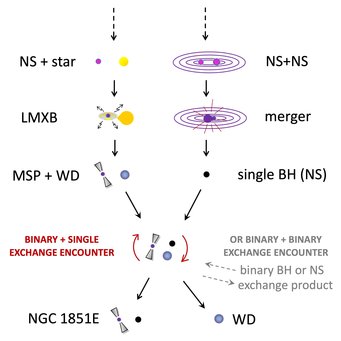Enigmatic companion with a weight problem
Radio telescope discovers system of a pulsar and an unknown object at the boundary between black hole and neutron star
When astronomers cannot explain something directly, it often becomes really exciting. An international team led by researchers from the Max Planck Institute for Radio Astronomy and with the participation of the Max Planck Institute for Gravitational Physics has now discovered a mysterious tandem that has never been observed before: a system consisting of a neutron star and an object that, at first glance, should not even exist. But there is a hot lead.

Researchers from the international collaboration "Transients and Pulsars with MeerKAT" (Trapum) have discovered a new system of two orbiting objects located in the globular cluster NGC 1851 in the southern constellation Columba (Dove). Both objects most likely have one thing in common: both must have emerged, albeit indirectly, from the remnants of massive stars, i.e. from neutron stars or black holes.
Massive stars are frequently formed in multiple star systems. And it is precisely these stars that die at the end of their lives in a spectacular supernova explosion. The remnants: black holes or neutron stars that orbit each other if the system has survived the explosion. So far, only tandems of black holes and neutron stars have been detected by the gravitational waves they emit during their close dance.
A pulsar sets the beat

At least the nature of one of both objects is known. The team used the sensitive MeerKAT radio telescope in South Africa in combination with powerful detectors from the Max Planck Institute for Radio Astronomy and registered weak pulses. It is a neutron star with a strong magnetic field that rotates very quickly, emitting radio waves along opposing light cones that sweep through the universe like a cosmic lighthouse. The newly discovered pulsar called PSR J0514-4002E rotates around its own axis more than 170 times per second and hits the Earth with its radio light just as often. With each rotation, the radio telescope registers a pulse, similar to the ticking of a clock. The so-called radio pulsar ticks extremely regularly.
The researchers used small deviations or differences in the rate of this clock to draw conclusions about a companion orbiting a common centre of gravity together with the pulsar as part of a binary system. The Doppler effect causes the pulsar's radio frequency to change as a result of its orbital motion, like the frequency of a fire engine siren travelling past an observer. This also made it possible to determine the pulsar's orbit around the mysterious object. “Think of it like being able to drop an almost perfect stopwatch into orbit around a star almost 40,000 light years away and then being able to time those orbits with microsecond precision”, says Ewan Barr, who led the study together with Arunima Dutta from the Max Planck Institute for Radio Astronomy.
"When we looked at Hubble images, we saw nothing"
The situation is less clear when it comes to the companion object orbiting the pulsar. „When we looked at Hubble images of NGC 1851, we saw nothing at that position,” explains Prajwal Voraganti Padmanabh at the Max Planck Institute for Gravitational Physics (Albert Einstein Institute) in Hannover. “Hence, the object in orbit with the pulsar is not a normal star, but an extremely dense remnant of a collapsed star.” If this were also a star, it would, like the sun, emit a stellar wind, which the pulsar's radio light cone would have to pass through before the radio telescope receives a signal. In this case, the stellar wind would characteristically influence the frequencies of the radio signal. However, there are no signs of such an effect in the radio data. Everything indicates that the mysterious object is an extremely dense remnant of a collapsed star: a black hole or another neutron star that does not emit radio light.
The search for clues continues: the astronomers not only deduced the orbit from the measurements of the pulsar clock's rate differences, but also narrowed down the mass of the second object to between 2.09 and 2.71 solar masses. This means that the companion could be heavier than the heaviest known neutron stars (around two solar masses) and at the same time lighter than the lightest known black holes (around five solar masses). The compact companion object that researchers detected with the help of the radio pulsar therefore falls precisely into the so-called mass gap of black holes. Why no other compact object between two and five solar masses has yet been found is not fully understood. “Whatever this object is, it is exciting news”, says Paulo Freire of the Max Planck Institute for Radio Astronomy. “If it is a black hole, it will be the first pulsar - black hole system known, which has been a Holy Grail of pulsar astronomy for decades! If it is a neutron star, this will have fundamental implications for our understanding of the unknown state of matter at these incredible densities!”
Born from Neutron Stars?
Neutron stars, the ultra-dense remains of a supernova explosion, can only be so heavy. Once they’ve acquired too much mass, perhaps by consuming another star or maybe by colliding with another of their kind, they will collapse. What exactly they become once they collapse is the cause of much speculation, with various wild and wonderful flavours of exotic stars being proposed. The prevailing opinion, however, is that neutron stars collapse to become black holes, objects so gravitationally attractive that even light cannot escape them. Theory, backed by observation, tells us that the lightest black holes that can be created by collapsing stars are about 5 times more massive than the Sun. This is considerably larger than the 2.2 times the mass of the sun required for neutron star collapse, giving rise to what is known as the black hole mass gap. The nature of compact objects in this mass gap is unknown and detailed study has thus far proved challenging due to only fleeting glimpses of such objects being caught in observations of gravitational wave merger events in the distant universe.
While the team cannot conclusively say whether they have discovered the most massive neutron star known, the lightest black hole known or even some new exotic star variant, what is certain is that they have uncovered a unique laboratory for probing the properties of matter under the most extreme conditions in the Universe. “We're not done with this system yet,“ says Arunima Dutta. “Uncovering the true nature of the companion will a turning point in our understanding of neutron stars, black holes, and whatever else might be lurking in the black hole mass gap!”.
NJ, BEU, BK
Additional Information
A possible explanation for the newly discovered compact object:

The team proposes that the detected system is the result of a rather exotic formation history, only possible due to its particular local environment. The system is found in the globular cluster NGC 1851, a dense collection of old stars that are much more tightly packed than the stars in the rest of the Galaxy. Here, it is so crowded that the stars can interact with each other, disrupting orbits and in the most extreme cases colliding. It is one such collision between two neutron stars that is proposed to have created the massive object that now orbits the radio pulsar.
On the left side of the figure it is shown how the millisecond pulsar (MSP), PSR J0514-4002E, could have formed. Matter from a compansion star streams onto the surface of a neutron star. This also transfers angular momentum to the neutron star, which accelerates the neutron star’s rotation around its own axis. The result is a rapidly spinning pulsar and a white dwarf orbiting each other - a typical configuration observed throughout the galaxy.
The right-hand side of the image shows how the mysterious object orbiting the radio pulsar could have formed. Two neutron stars in orbit (NS + NS) emit gravitational waves, causing the system to lose energy and the orbit shrinks with time. This eventually leads to an explosive neutron star merger. The outcome of the merger is an isolated low-mass black hole (BH) or possibly a supermassive neutron star. At some later time the black hole and the pulsar - white dwarf binary meet, resulting in an exchange encounter in which the lightest of the three stars (in this case the white dwarf) is kicked out of orbit. The result is a stable pulsar - black hole system.
MeerKAT: Operated by the South African Radio Astronomy Observatory (SARAO), MeerKAT is the largest radio telescope in the Southern hemisphere and one of two precursor instruments of the SKA Project based in South Africa. Located in the Karoo semi-desert, the radio telescope will soon be expanded with an additional number of dishes, in the context of the “MeerKAT+” project, jointly funded by SARAO and the Max-Planck-Gesellschaft (MPG) in Germany. The telescope will later be gradually integrated into SKAO's Mid telescope in South Africa.
TRAPUM: Transients and Pulsars with MeerKAT (TRAPUM) is an ongoing survey project using the MeerKAT radio telescope. The project's members form an international collaboration representing universities and research institutes in 10 countries, led by Prof. Michael Kramer (Max Planck Institute for Radio Astronomy, Germany) and Prof. Benjamin Stappers (University of Manchester, UK). The goals of the TRAPUM survey and collaboration are to observe targets of special interest in search of radio pulsars. Observations focus on Fermi-LAT detected gamma-ray sources, globular clusters, supernova remnants and nearby galaxies. To date, TRAPUM and its sister projects have discovered more than 200 pulsars with MeerKAT.














